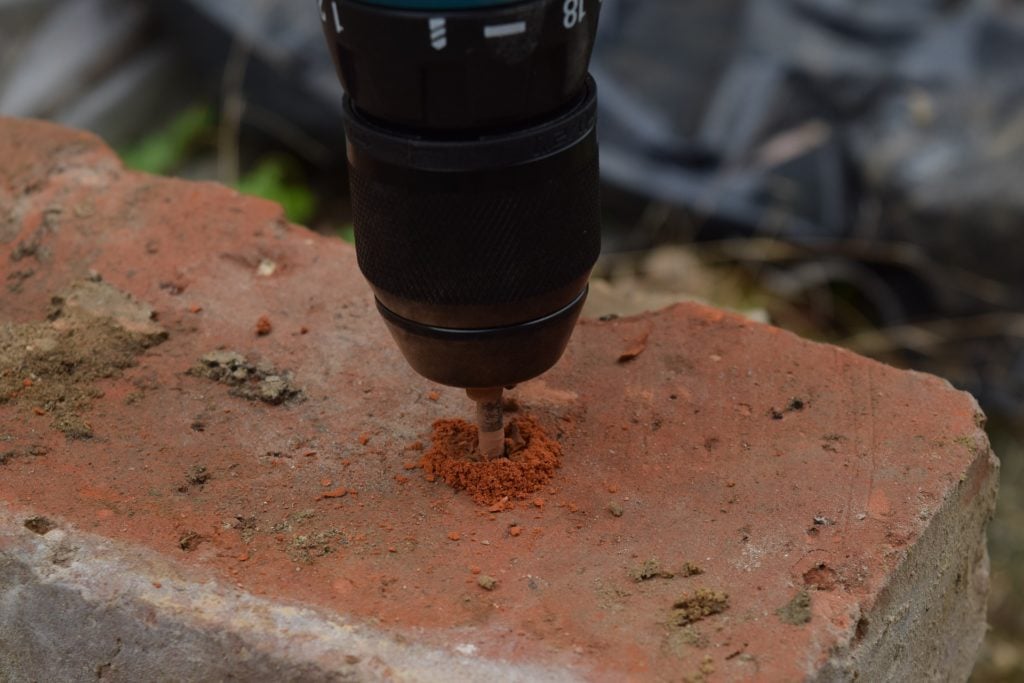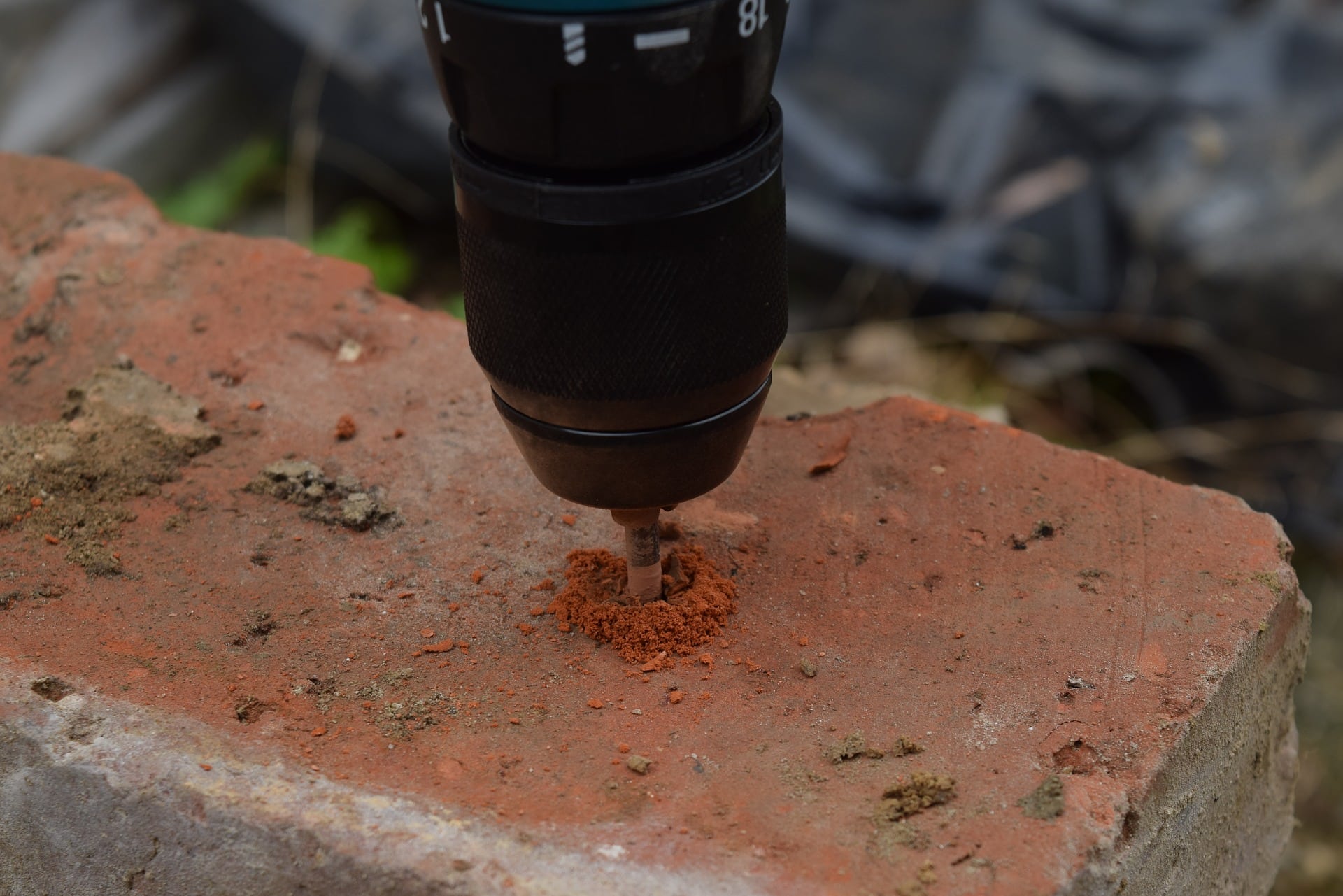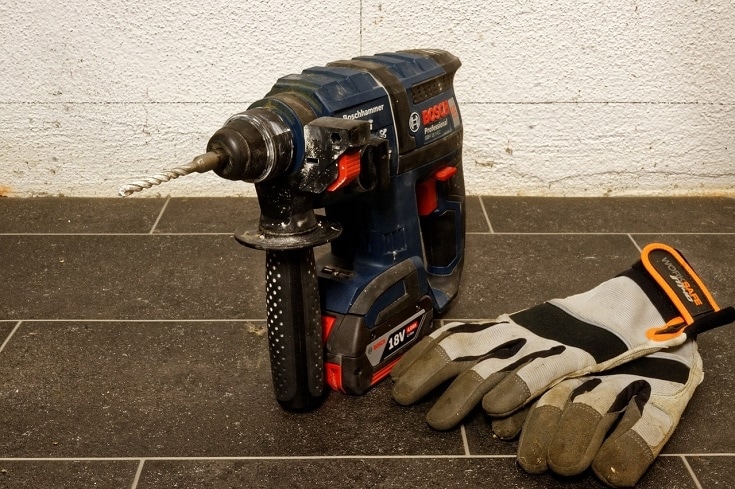How to Drill into Brick (Step-by-Step DIY Guide)
-

- Last updated:


If you have a brick surface that you need to drill into to hang pictures, a mailbox, or other devices, you might be surprised to find out it’s not as difficult as it seems. The right tools and a little knowledge is all you need to make short work of this task. Join us while we go over everything you need to get started and provide you with a detailed list of steps to drill into brick surfaces with little effort.
Type of Drill Required
The tools you will require will depend on the size of the hole that you need to make.
Standard Drill: max 1-inch deep, ¼-inch wide
For holes up to ¼-inch wide that need to go in about 1-inch, you can use your standard drill in most instances. Some of the older rechargeable models might not have the torque you need, but any model with an 18-volt lithium-ion battery should work fine, and most corded models will work.
The trick here is to use high-quality carbide, or carbide-tipped drill bits, which are more expensive but can handle the heat and pressure required for drilling into brick. You won’t need to purchase a whole set, only get the ones you need.
Hammer Drill: larger than 1-inch deep. ¼-inch wide
Holes larger than ¼-inch wide and 1-inch deep will require a hammer drill. This type of drill is similar to a standard drill bit typically has a larger motor and a handle on the side to allow you to exert more force to penetrate the brick. Hammer drills also provide a slight hammering action that helps the bit push its way into the brick surface.
There are many suitable models available for purchase from DeWalt, Makita, and many others, but unless you are doing this kind of work all the time, it may be better to rent it from a local hardware store. Many larger stores like Lowes, Home Depot, and Ace Hardware allow you to rent the tools you need for a reasonable fee, and you won’t need to worry about adding wear and tear to the tools you own.
Pro Tip
No matter which road you choose, get a model with a depth stop, so you don’t drill too deep, multiple speed settings, and the sidearm we mentioned earlier. You will also need carbide masonry bits that you may be able to rent along with the tool.
Other Factors to Consider
Brick or Mortar?
When you are preplanning where to drill your holes, you will need to decide if you will put them in the brick or the mortar surrounding them.
When to drill into the brick?
Brick is harder and doesn’t chip or crack as easily as mortar, so it will last longer and support more weight. However, drilling too deep will weaken the brick, so it’s best to drill into the brick when the holes are less than 1-inch deep.
When to drill into the mortar?
If the brick is getting old, it will be more fragile and may already have cracks that weaken the brick. Holes deeper than one inch can also weaken the brick, and expansion anchors can crack them, so it’s best to drill into the mortar in these cases. Drilling into the mortar leaves the bricks wholly intact, and expansion anchors won’t damage them.
Another reason you might drill into mortar instead of the brick is that you can fill the hole you make with an inexpensive mortar repair kit. If you drill a hole in the wrong place in brick, there is no way to cover it.
Safety Equipment
When drilling into brick, it’s important to wear several safety items to protect yourself and your health, including safety glasses, hearing protection, dust mask, and work gloves.
Safety Glasses
Drilling can send particles into the air that can land in your eye, especially when using a hammer drill. It’s best to wear a pair of safety glasses with side protection while you are working.
Hearing Protection
Some hammer drills can get quite loud, and you will want to protect your hearing with a set of earplugs or pair of earmuffs while you work.
Dust Mask
Drilling can create tiny dust particles that can enter the lungs, causing health problems, especially when using the drill indoors or over your head. It’s best to wear an N95 style mask at all times while you are drilling into a brick surface.
Work Gloves
Work gloves aren’t as essential as the face mask and safety goggles. However, it’s easy to get scraped and cut while working with brick, so it’s a good idea to wear them while you are working.
- See Also: How to Drill Into Concrete
Additional Equipment
Here are a few additional items you will want to have ready before you get started.
- Tape measure
- Pencil or marker
- Masking tape
- Ladder
- Broom and dustpan
- Shop-Vac
- Mop
- Wall anchors
Drilling into Brick
1. Mark where you intend to drill
The first step is to carefully measure and mark where you intend to drill with a pencil or marker. Double-check your measurements with any mounting brackets you intend to use. Take your time as this is the most important step.
2. Set up your stop
Next, you will set up the stop on your drill, so you only drill as deep as you need to. If you didn’t get a drill with an adjustable stop, you could put masking tape on the drill bit to mark how deep you can drill.
3. Put on your safety gear
If you’re not already wearing the safety gear we mentioned earlier, now is the time to put it on. Don’t try to save time at the risk of your health, no matter how small the project is.
4. Set up the ladder
If you are using a ladder or step stool, you will want to set it up at this time and make sure it’s stable and safe to climb. Get a spotter to help if you need one.
5. Pilot hole
Use a smaller drill bit than the one you need to make a pilot hole that the larger bit can follow. Make sure the bit is at a 90-degree angle to the wall and use a slow speed. Use the auxiliary handle to increase pressure and stability.
- If the bit begins to walk, stop, and reset in at the correct position.
- If your drill has only one speed, use a pulse drilling technique to keep the motor temperature down. Frequent longer breaks can also help protect the tool from damage due to overheating.
6. Drill hole
With the pilot hole created, switch to the correct size bit and drill the hole you need using the pilot as a guide. Once again, you want the bit at a 90-degree angle to the brick for maximum strength.

7. Install your wall anchor
Wall anchors push into the hole and support the weight of heavy objects.
8. Clean up
When you finish drilling the holes, clean up the area before anything else while still wearing your safety equipment. The dust kicked up from the broom or shop vac will be just as hazardous to your health. It’s also important to wipe off your shoes, wash your clothes, and take a shower to prevent silica dust from contaminating your environment.
9. Hang your item
With the area clean, you are free to hang your item at your leisure.
Summary
Drilling into brick is not difficult if you use the right tools. Since drilling into brick and masonry isn’t something we often do, it’s hard to justify the cost of an expensive hammer drill by DeWalt or Makita, so we recommend renting one from your local hardware store. Remember to use carbide bits, and the process won’t be much more difficult than drilling an ordinary hole in wood, though it will take longer.
If we have helped you learn something new, please share this guide to drilling into a brick on Facebook and Twitter.
See Also:
- How to Drill a Hole in Ceramic (Step-by-Step DIY Guide)
- How to Drill into Concrete (Step-by-Step DIY Guide)
Featured Image Credit: naetoo, Pixabay
Contents






